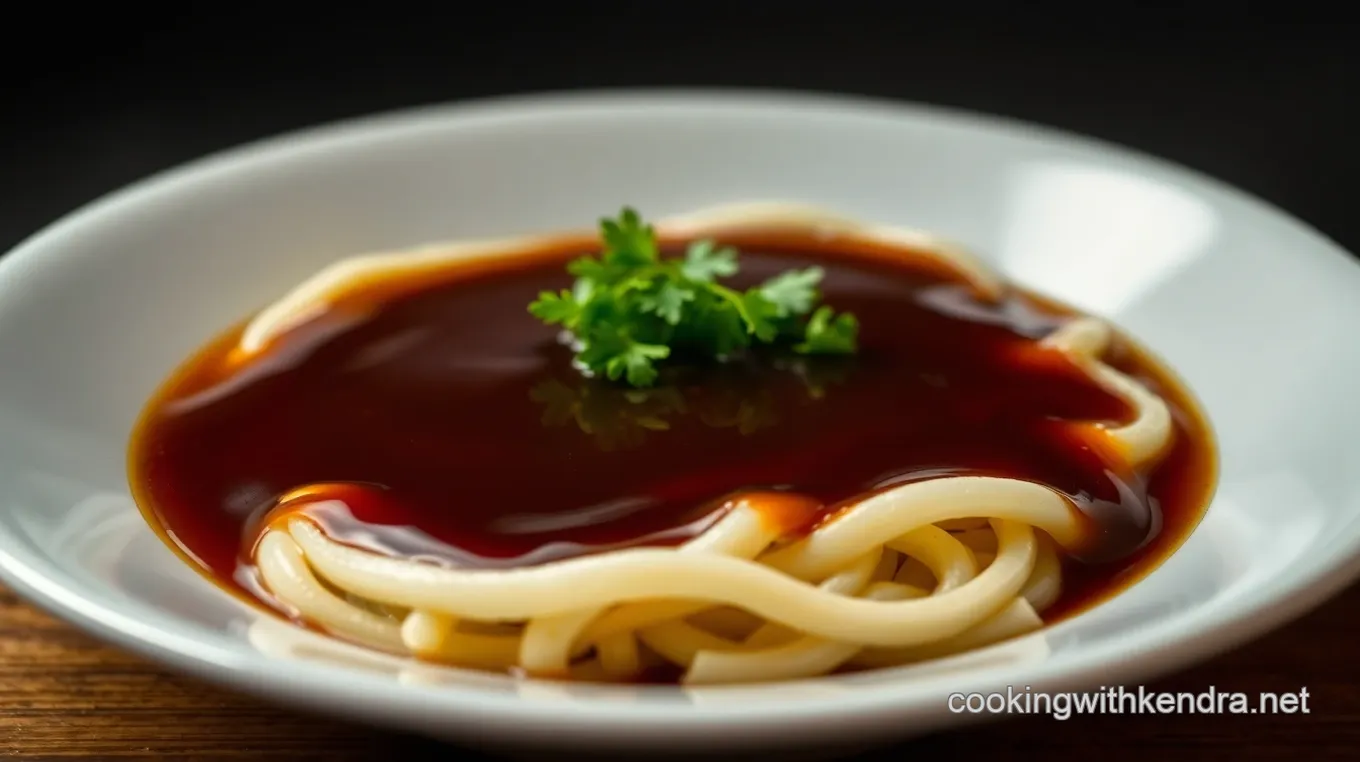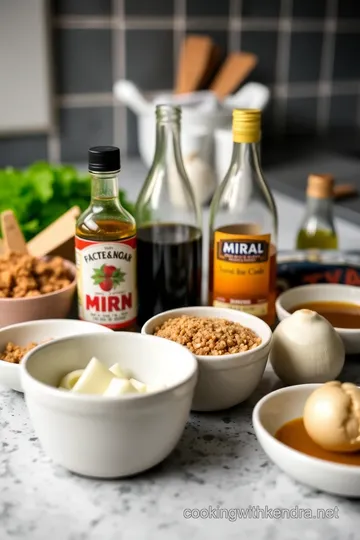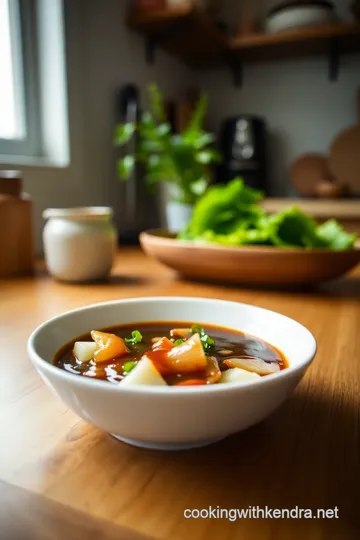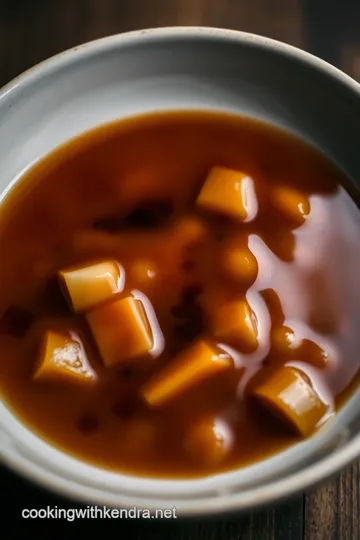Homemade Soyaki Sauce: An Asian Fusion Delight
Try my easy homemade soyaki sauce! This delicious blend is perfect for marinades, stir-fries, and dipping. Elevate your dishes with savory goodness!

- A Sweet and Savory Journey into Soyaki Sauce
- Your Essential Ingredients Guide for Delicious Cooking
- Mastering the Art of Cooking with Soyaki Sauce
- Pro Tips & Secrets to Mastering Soyaki Sauce
- Perfect Presentation Ideas
- Storage & Make-Ahead Strategies
- Creative Variations to Spice Things Up
- Complete Nutrition Guide for Soyaki Sauce Lovers
- Conclusion: look into into Deliciousness!
- Frequently Asked Questions
- Recipe Card
A Sweet and Savory Journey into Soyaki Sauce
Oh man, let me take you back to a sunny tuesday when i decided to whip up dinner for a few friends.
I had no clue what to make, but i stumbled upon that magical bottle of soyaki sauce sitting in my fridge.
It was a blend that promised sweetness and richness, and with just a few ingredients, i knew it would become the star of the night.
So i questioned myself, "why not make an asian-inspired feast?" spoiler alert: they loved it!
Now, have you ever found yourself struggling to figure out what to serve for dinner? you're not alone! whether it’s wednesday night or the big game day, every home cook wants something that feels special but doesn’t break the bank or require hours in the kitchen.
That's where this vibrant soyaki sauce comes into play.
Soyaki Sauce: A Delicious Twist
So, let’s get into a little history, shall we? soyaki sauce is like the cool cousin of the classic soy and teriyaki sauces we all know and love.
Originating from japanese cuisine, it’s a beautiful mix of sweet and savory notes that have captured hearts worldwide. nowadays, you'll find this sauce on menus from food trucks to high-end restaurants.
Plus, it’s so simple to make at home!
Wondering how long it takes? just 15 minutes is all you need—what?! yep, you read that right. prep time is just 10 minutes , and then a quick 5-minute simmer to meld those flavors.
Honestly, anyone can nail this one; it’s super easy. when you whip up your own soyaki sauce, you'll save money over buying bottled sauces while controlling the ingredients.
Talk about a win-win!
Benefits of Making Your Own Soyaki Sauce
Now let’s talk about the perks of making your own soyaki. first up, it’s healthy! soyaki sauce has plenty of nutrition highlights—less sodium than store-bought options, and you can adjust the sweetness to fit your dietary needs.
Woo hoo! if you’re looking for gluten-free options, just switch up the soy sauce with tamari, and you’re good to go!
This sauce adds a lot of punch, making it perfect for special occasions—think grilled meats recipes or even a gathering with friends for an asian fusion dinner.
Impress them with something homemade! oh, and side note—if you're hosting a gathering, soyaki sauce works wonders as a dipping sauce for grilled veggies or even tofu marinades.
What makes it stand out against other sauces? it’s the balance of flavors! you get the sweetness from brown sugar, depth from soy sauce, and that kick from fresh garlic and ginger.
It’s like a symphony in your mouth, and who doesn’t want that?
From Pantry to Plate: Preparing the Soyaki Sauce
Ready to give this homemade sauce a go? let me give you the lowdown on what you need. you’re going to use common pantry staples: soy sauce, mirin, some garlic, ginger, and a few others.
No need for fancy ingredients; i promise it’ll taste like a million bucks!
Now that you’re pumped, let’s transition into the ingredients section. i’ll break down everything you need to get that sweet and savory magic flowing right into your kitchen.
Whether you want to drizzle this over grilled chicken, add it to your stir-fry sauce , or use it for your veggie dishes, the possibilities are endless!
Stay tuned, and get ready to have some fun cooking! Let’s dive into the magic of making your own soyaki sauce. You’ll feel like a pro chef in no time!

Your Essential Ingredients Guide for Delicious Cooking
Let’s chat about those premium core components that can make or break a dish! whether you’re whipping up a stir-fry or drenching grilled meats in your homemade sauces, knowing your ingredients is key.
You'll want to keep it organized, so let’s break it down into small, digestible bits, shall we?
Premium Core Components
When it comes to cooking, having the right ingredients is everything. Don’t worry; I’ll keep this simple.
First off, measurements matter! For the sake of clarity, let’s stick to those classic measurements. If you're a stickler for precision, here’s a quick rundown:
- 1 cup of soy sauce is roughly 240 ml .
- For my metric friends, remember that 1 tablespoon equals about 15 ml .
Next, let’s chat about quality indicators . fresh is best! look for vibrant colors and a pleasant aroma. when it comes to sauces like soy sauce, always check the label.
Authentic stuff will rock your world compared to those imitation bottles.
Storage guidelines ? easy peasy! most sauces can chill in the fridge for a good while, but always check the date.
Can you believe some homemade sauces can last up to two weeks?
And if you want a fresh ingredient game changer, give your garlic and ginger a quick sniff. if it smells off, don’t even think twice—toss it.
That brings out the best in your cooking!
Signature Seasoning Blend
Ah, seasoning blend —the magic dust of culinary delight! When I think of sauces for stir-fries or sweet and savory sauces, nothing beats the comforting warmth of classic spices.
Start with essentials: garlic powder, ginger, and maybe some cayenne for a kick. you can even play around with herb selections .
Fresh cilantro and scallions brighten things up like a shot of espresso! pair them with soy sauce for a killer combo.
Flavor enhancers ? Think sesame oil, flavored vinegars, and a sprinkle of sesame seeds. Oh, and don’t overlook regional variations ! A hint of miso or sriracha can take your soyaki sauce from basic to “Oh my gosh, what’s in this?”
Smart Substitutions
Cooking doesn’t always go as planned. what happens when you reach for that mirin and it’s nowhere to be found? smart substitutions to the rescue! honey or agave syrup mixes easily with a splash of water for a close match.
Dietary restrictions? No sweat! Switch out soy sauce for tamari to get that gluten-free soyaki going.
And you know those emergency replacements ? if you ever run out of rice vinegar, apple cider vinegar will work in a pinch.
It might even give you a bit of a fruity twist. genius, right?
Kitchen Equipment Essentials
Now, let’s move on to the tools of the trade—kitchen equipment essentials! trust me, a few must-haves can make your life easier.
A good whisk, a small saucepan, and measuring cups are non-negotiable.
But what if you don’t have a whisk? No problem! A fork works too—just put some elbow grease into it!
Now, let’s not forget about storage solutions . An airtight container is your best friend here. Your homemade sauces deserve a comfy spot in the fridge!
Wrapping It Up
So there you have it, friends! knowing your core ingredients, signature seasoning blends, and smart substitutions elevates your cooking, turning everyday meals into something extraordinary.
And when you whip up that soyaki sauce , you’ll be the hero of your dinner table.
Ready to dive into the specifics? we've got the juicy step-by-step instructions coming right up, so hang tight for some delicious fun! you'll want to stick around for how to craft that perfect homemade soyaki sauce.
It’s time to bring those flavorful sauces to life!

Mastering the Art of Cooking with Soyaki Sauce
Alright, friends, let’s dive into the world of professional cooking methods using a fabulous ingredient that can jazz up just about any dish— soyaki sauce ! this homemade concoction is not just a mix of soy sauce and a few extras; it’s a magical blend of flavors that’ll make your taste buds do a happy dance.
Essential Preparation Steps
First things first, we gotta talk about mise en place . this french term just means “everything in its place.” before you even crack that bottle of soyaki sauce, gather all your ingredients.
Measure your ½ cup of soy sauce , ¼ cup of mirin , and don’t forget the 2 tablespoons of brown sugar —trust me, it’s key for that sweet-savory balance!
Time management is crucial. if you're like me and tend to get distracted while cooking (ooh, look, a cat!), plan your steps.
Get everything prepped: chop that garlic, grate the ginger, and mix your cornstarch slurry beforehand. you want to keep things flowing smoothly when it's cooking time.
Speaking of flow, let’s chat organization strategies . keep your workspace clean and clutter-free. it helps you focus and, hey, minimizes the chance of knocking over that gorgeous bottle of homemade soyaki sauce! and a little tip about safety considerations —always keep a towel handy for any spills.
Hot sauce and slippery floors? no, thanks!
Step-by-Step Process
Let's roll up those sleeves! Here’s how you whip up this sauce from scratch.
-
Combine ingredients: in a small saucepan, toss in soy sauce , mirin , brown sugar , rice vinegar , sesame oil , minced garlic , and fresh ginger .
Stir it all together like you’re trying to solve a mystery—because you are!
-
Heat the Sauce: Crank that stove to medium heat and stir until the sugar is fully dissolved.
-
Simmer: Bring it to a gentle simmer (about 3- 5 minutes ). This is where the magic happens, and the flavors meld beautifully.
-
Thicken the Sauce: Remember that cornstarch slurry you made? Gradually whisk it into your simmering sauce.
-
Cook until thickened: continue cooking for another minute or until it reaches that perfect sauce consistency. you know it’s done when it coats the back of a spoon—aim for rich and thick, my friends.
-
Store or Serve: Let it cool before using it or transferring it to an airtight container. This sauce can last in the fridge for up to two weeks, but let’s be honest—it probably won't last that long!
Expert Techniques
Now that you’ve got the basics down, let’s sprinkle in some expert techniques . everyone messes up at some point. some common mistakes to avoid include adding the cornstarch slurry too quickly or not letting the sauce cool properly before storing.
Trust me; i've been there!
For a little quality assurance , taste as you go. if the sauce feels too salty, a dash of sugar can balance it out.
If it’s too sweet, a splash of vinegar brings it back to life.
And here’s a pro tip to troubleshoot: If your sauce winds up too thick, just whisk in a little water to loosen it up.
Success Strategies
Now, let’s talk about those success strategies . Always taste your soyaki sauce; don’t assume it’s perfect just because the recipe says so!
A classic mistake? Not preparing enough sauce for grilled meats or stir-fried veggies. Make a double batch . You’ll thank yourself on a busy weeknight! This soyaki sauce isn’t just perfect for drizzling; it makes a fabulous tofu marinade or a dipping sauce for fresh spring rolls!
Oh, and if you want to prep ahead, think about making a big batch and freezing some in ice cube trays. You’ll have quick sauce recipes ready when you need them.
Additional Information
There you have it—a full guide on mastering the beautiful art of cooking with soyaki sauce! from essential preparation to your expert techniques, this sauce thrives on creativity and spontaneity.
Whether you use it as a marinade, a dipping sauce, or in your stir-fried creations, it’s bound to become a go-to in your kitchen.
So go ahead, experiment with other Asian sauces and get ready for the savory experience of cooking with soy sauce in all your favorite meals!

Pro Tips & Secrets to Mastering Soyaki Sauce
Let’s talk about those chef's personal insights that can really elevate your soyaki sauce game. one thing i’ve learned is that fresh ingredients are key.
Trust me, fresh garlic and ginger can really amp up the flavor compared to dried. don’t skimp here! it’s like the difference between fast food fries and the homemade crispy kind.
When you're in a rush, try this time-saving technique : make a big batch and freeze it! you can put the soyaki sauce into ice cube trays and pop out a cube whenever you need a quick sauce.
Perfect for those days when you want to whip up an easy asian recipe but are short on time.
Looking to enhance those flavors? a splash of rice vinegar works wonders in bringing balance to the sweetness. or, if you’re feeling adventurous, add a drop or two of sriracha for a zesty lift.
Oh my gosh, just thinking about it makes my mouth water!
And presentation? Don't underestimate it! A drizzle of soyaki sauce over your dish can make your evening meal feel like a feast. Serve it with confidence, and your friends will be impressed!
Perfect Presentation Ideas
You know what they say about we eat with our eyes first, right? so, let's get into some plating techniques ! you can serve grilled chicken or beef skewers and drizzle the sauce over them in a zig-zag motion.
It’s an easy way to make your meal pop!
For garnish ideas , consider sprinkling sesame seeds on top or adding thinly sliced green onions to give a splash of color. Honestly, colors make everything look yummier, don’t you think?
Don’t forget about color combinations ! a vibrant stir-fry with bell peppers and snap peas looks stunning against the rich brown of your soyaki sauce.
Just remember the visual appeal —it's all about balance. you want a plate that makes you say, "wow!"
Storage & Make-Ahead Strategies
So, how do you make sure that amazing flavor lasts? here are my storage guidelines for that tasty soyaki sauce.
Store it in an airtight container in your fridge, and it’ll last for about two weeks . it actually gets better with time as those flavors meld together—talk about win-win!
If you're thinking about preservation methods , I've had success freezing it too. Just pour it into a resealable freezer bag, lay it flat in your freezer, and you’ll have soyaki sauce ready to go for ages!
Now, reheating is super simple; just warm it up in a small pan over low heat. if it’s too thick, splash in a bit of water to get it back to that perfect consistency.
You don’t want to ruin your mini masterpiece!
Creative Variations to Spice Things Up
Let’s get creative! This soyaki marinade is so versatile that you can adapt it to fit any flavor profile. Have you tried a fruity twist? Adding pineapple juice or even peach puree can elevate your sauce with a summer vibe—so refreshing!
For those with dietary preferences, feel free to swap soy sauce for tamari to keep it gluten-free. or, make your own simple marinade recipes by playing around with the base.
You could even try it with honey or agave in place of brown sugar for a different sweet kick.
What about regional variations ? if you're feeling a little more adventurous, try infusing it with hoisin sauce or sesame oil for a unique twist.
The world of asian sauces is just waiting for you!
Complete Nutrition Guide for Soyaki Sauce Lovers
Let’s get down to the nitty-gritty—here’s a quick nutrition guide so you know what you’re putting into your body. Each serving has about 35 calories , which is pretty light for a sauce that packs such a flavorful punch!
It’s got some health benefits too! the ginger in it is a great digestive aid, and soy sauce can provide a good dose of protein.
But if you're watching out for those sodium levels, remember that moderation is key!
Of course, if you’re enjoying it on grilled meats or veggies, make sure you’re balancing out your meals with plenty of greens.
Portion guidance? a tablespoon or two should be plenty, especially when used as a dipping sauce.
Conclusion: look into into Deliciousness!
There you have it, folks! whether you're whipping up a simple weeknight meal or hosting a dinner party, this soyaki sauce will be the star of the show.
Experiment, adjust, and have fun with your cooking!
Seriously, don't sweat the small stuff. Enjoy the process, and let your kitchen become your happy place. Your friends and family will love the flavorful sauces you create, and who knows? You might just become the soy sauce guru of your circle! Happy cooking!
Frequently Asked Questions
What is soyaki sauce and how is it different from teriyaki sauce?
Soyaki sauce is a delicious blend that combines elements of traditional soy sauce and teriyaki sauce, bringing together sweet, savory, and umami flavors. Unlike teriyaki, which is typically thicker and sweeter, soyaki sauce has a more balanced profile that makes it versatile for marinades and dipping sauces.
Can I make soyaki sauce gluten-free?
Absolutely! To make soyaki sauce gluten-free, simply substitute regular soy sauce with tamari, which is made without wheat. All other ingredients in the recipe, like rice vinegar and sesame oil, are naturally gluten-free, making it easy to enjoy this flavorful sauce without gluten.
How should I store homemade soyaki sauce?
Store your homemade soyaki sauce in an airtight container in the refrigerator, where it will keep well for up to two weeks. As the sauce sits, the flavors will deepen, making it even more delicious for later use!
Can I adjust the sweetness of the soyaki sauce to my liking?
Yes, you can easily adjust the sweetness of your soyaki sauce! Feel free to modify the amount of brown sugar based on your personal preference, or use natural sweeteners like maple syrup or honey as alternatives. Start with small adjustments and taste as you go to achieve your desired flavor.
What are some serving suggestions for soyaki sauce?
Soyaki sauce is incredibly versatile! You can use it as a marinade for grilled chicken, beef, or tofu, drizzle it over roasted vegetables, or mix it into stir-fries for added flavor. It's also delightful as a dipping sauce for spring rolls or dumplings.
Can I freeze soyaki sauce for later use?
Yes, you can freeze soyaki sauce! Just pour it into ice cube trays or small containers, and once frozen, transfer the cubes to a freezer-safe bag or container for easy portioning. This allows you to have quick access to your favorite sauce whenever you need it!
Homemade Soyaki Sauce: An Asian Fusion Delight Card

⚖️ Ingredients:
- ½ cup (120 ml) soy sauce (or tamari for gluten-free)
- ¼ cup (60 ml) mirin (sweet rice wine)
- 2 tablespoons (30 g) brown sugar
- 1 tablespoon (15 ml) rice vinegar
- 1 tablespoon (15 ml) sesame oil
- 2 cloves garlic, minced
- 1 teaspoon grated fresh ginger
- 1 tablespoon (8 g) cornstarch (for thickening)
- 2 tablespoons (30 ml) water (for cornstarch slurry)
🥄 Instructions:
- Step 1: In a small saucepan, mix soy sauce, mirin, brown sugar, rice vinegar, sesame oil, minced garlic, and grated ginger.
- Step 2: Place the saucepan over medium heat and stir to dissolve the sugar.
- Step 3: Bring to a gentle simmer, allowing the flavors to meld for about 3-5 minutes.
- Step 4: In a small bowl, combine cornstarch and water to create a slurry. Gradually whisk this into the simmering sauce.
- Step 5: Continue to cook for another minute or until the sauce thickens to your desired consistency. Remove from heat and let cool.
- Step 6: Use immediately or cool completely before transferring to an airtight container for storage in the refrigerator.
Previous Recipe: My Easy and Refreshing Mangoneada Recipe: A Sweet Mexican Delight
Next Recipe: Delicious Substitute for Sage: Herb-Infused Roasted Chicken Recipe
